Last week, I received a fascinating comment from Giles, a follower of this blog, who is as intrigued by Robin William George Stephens as I am. Giles had come across a Sydney Sun (New South Wales) newspaper article from 1938 which featured the recollections of an aviatrix who had met Stephens in Addis Ababa (Abyssinia) several years earlier.
The aviatrix, known only as Mrs. Charles Lloyd, considered Stephens to be the “most interesting man I ever met” and admitted that she thought he was quite mad the first time she saw him… and that there was something queer about him… but we’ll let her tell the tale. I have added some comments in italicized square brackets…
The Most Interesting Man I Ever Met.
—Capt. Robin Stephens
“Looking back now,” said Mrs. Charles Lloyd, English-born world traveller and aviatrix who has made a temporary halt in her travelling to spend a few weeks in Sydney, “the man I consider the most interesting gave me the impression that he was quite mad the first time I saw him.”
Mrs. Lloyd, who was interviewed in her suite at the Hotel Australia, couldn’t help laughing as she thought of the incident.
“It was in a night club at Addis Ababa,” she continued, “and in the middle of the dance floor was Captain Robin Stephens, Second in Command [he was the adjutant, another doctor was second-in-command] of the British Red Cross in Abysinnia [sic], gravely alternating a neat balancing trick with chairs and tables and a sword dance—walking sticks taking the place of the swords. I thought there must have been something queer about him, but subsequent introductions proved that he was just relaxing after a hard and dangerous journey back from the battle front with an ambulance unit.
“I think it was his amazing versatility that made Captain Stephens such an interesting man. He is English, born in Alexandria, and talks in 14 languages [I’ve only heard of 7 or 8] , including Arabic, which he speaks like a native [interesting, not one of the languages he claimed on his Army application]. A good deal of his younger life was spent in India in the army, where he was cavalry master [really?] to a crack Indian regiment [Gurkhas?]. After that he went on circuit as a judge [deputy judge advocate]. He is a fully fledged solicitor and lawyer, and has an office in Temple’s Field, London [I have found no evidence that he passed the final exams or was called to the Bar]. How he managed that at the same time as working for the Red Cross I don’t know. [He studied law before the Red Cross.]
“To add to the list of his qualifications, he writes beautiful poetry, rather in the style of Rupert Brooke [fascinating… Stephens’ father was also a poet], and also he has collaborated with his uncle, Sir William Lushington Stephens [actually Sir Harry Lushington Stephen – not an uncle or any relation], in writing law books and articles.
“He was known in Abyssinia as “Periscope No. 2” a nickname he got for always wearing a monocle. [Given this interaction was in February, prior to the mustard gas attacks, it’s interesting that the monocle has already made an appearance. MI5 claims that Stephens wore the monocle after suffering eye damage due to mustard gas in Abyssinia.] “Periscope No. 1” was the nickname of his chief, John Melley [sic] who was head of the British Red Cross [in Ethiopia, not the entire British Red Cross].
“I admired him too for his courage, for all the time during the Abyssinian war, and he was in It from beginning to end, he was ill with heart trouble. [Confirmed by another source.] The Red Cross worked under tremendous difficulties and transport was a terrible problem. Captain Stephens kept on taking ambulance units backwards and forwards to the front, when the other national Red Cross Societies had stopped.
(Sydney Sun – 6 June 1938, page 27)
Well, well, well… fascinating stuff!! Some of the information isn’t entirely accurate, likely due to the distorting effects of Mrs. Lloyd’s faulty memory. But still… the overall gist is not bad. And… as we shall see… Mr. and Mrs. Charles Lloyd were mentioned by Stephens in his 1936 article for the St. Bart’s Hospital Journal. Clearly each side made an impression on the other.
But first… who was the rather anonymous Mrs. Charles Lloyd? Initial Google searches didn’t yield much, bringing up either Charles Lloyd, an American Jazz musician born in 1938, or Charles Lloyd Jones, an Australian businessman from the same era. But perseverance paid off.
The Lloyds in Ethiopia
Some tweaking of the search parameters yielded the following from a Facebook page (of all things). The page features documents related to the Imperial Ethiopian Air Force and includes quotes by Colonel John Charles Robinson. Robinson was an African-American aviator who assisted the Ethiopians during the Italo-Ethiopian war. He was known as the Brown Condor and was given command of the Ethiopian Air Force. I have added comments in square brackets and italics…
Tuesday February 25th, 1936
Letter from John [Charles Robinson] in Addis Ababa
to Claude Barnett in Chicago
COL J. C. ROBINSON – IMPERIALE ETHIOPIENNE AIR FORCE – ADDIS-ABABA – FEB 25 1936
Mr. Barnett:
Please excuse this letter as I am leaving in a few minutes for a 10 day flight in the North. The pictures of this accident was taken 10 minutes before the accident – and one 2 minutes after the airplane hit the ground. I was to go on this flight but was changed at the last moment. – The airplane was going to Jigiga to get a Egyptian Doctor who had died 4 days before. – The coffin was in the airplane to bring the Doctor back in – The Pilot was am Englishman, Captain [Frederick Charles Edney-Hayter] Hayter – who has only been flying with us about 7 or 8 weeks – The airplane was a Dragon Mouth [Moth?] with 2 engines – It could carry 4 people – Another one like it [Monospar St-25 also had 2 engines] crashed about 6 or 8 weeks ago with another English Pilot name Captain Lloyd – He just had arrived within a few miles of Addis Airport when he crashed – The big shot English Pilots don’t seem to be so good out here, as flying here is much different from other parts of the world. The pictures are the only ones taken just before the last flight of this airplane, and the only ones of the airplane while it is burning. I was the first one to reach the airplane just before it burst into fire. – No one else has these pictures as I have the negatives – Fighting is very hard in the North – we are able to hold our own – Rogers did not go so good with the people here as he is always talking about himself and what he has done and what he can do. I gave him all the help I could during his entire stay here, and arranged many things for him with the government – but he did not even tell me good by when he left. I suppose he thinks he is so big he can forget the bridge that carries him over – I hope to return after the rainy season starts, which is in June. Will write on my return to Addis, that is if I am able to get back.
Col Robinson
[N.B. The following appears to be either an appendix to Robinson’s report, or perhaps an addition by the creator of the Facebook Page.]
G-ADTE GAL ST.25 Monospar Jubilee ST25/59
G-ADTE Ursula Eileen Lloyd/ Hanworth 30.09.35 6313 Crashed Addis Alum Ethiopia 26.12.35 [24th?]
On December 20th 1935, British couple, (heiress) Ursula and Charles Lloyd, left Khartoum, heading to Addis Ababa to spend Christmas there in their ST-G-25 Monospar G-ADTE. Engine failure forced them to land near Addis Alem where they were arrested and imprisoned, suspected of being Italians. Having been detained, they were released on the orders of the Emperor. Helped by the Ethiopians, repairs were made and they took off on December 24th for the capital, but crashed shortly after. The two were injured, Ursula Lloyd being more severely affected in the legs. A caravan accompanied by an English physician was sent to their rescue and stretchered them back more than 60 miles; Mrs. Lloyd spent three weeks in Addis Ababa hospital. She left Addis on the 7th March, and spent three weeks in Djibouti before leaving by sea.
Red Cross white painted De Havilland DH-84 Dragon Biplane, ex-G-ACKD, c/n 6052. It arrived on 21st January 1936 in Addis Ababa piloted by Charles F. Hayter (British). It crashed shortly after takeoff at Akaki on February 24th and burnt, both occupants were injured (Hayter was one).
Ah-hah!! I think these might be them! With some solid information, I was able to confirm the crash information on the Aviation Safety Network site, which also noted that the G-ADTE was first registered to Ursula Eileen Lloyd at Hanworth Aerodrome on 30 September 1935. I had thought that Hanworth might have been her maiden name but, no, it is the name of the aerodrome at which her aircraft was normally stationed or registered.
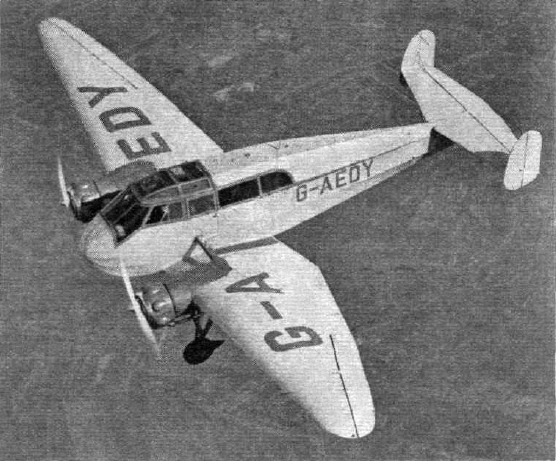
(This is not a Jubilee – but a Universal converted from a De-luxe)
(from Wikipedia)
Another site, the UK Register of Civilian Aircraft, noted that, in 1935, Ursula was residing at 11 Grosvenor Cottage, Eaton Terrace, London, SW1. According to this site, her aircraft was a Monospar St-25 manufactured by General Aircraft Ltd in Hanworth.
I even tracked down a rather unhelpful photograph of Ursula Eileen Lloyd (heiress). She may have been trying to avoid the paparazzi after a March 1935 court case (more on that below). While not showing us an image of her face, it is clear that Ursula is well-dressed and liked her furs.
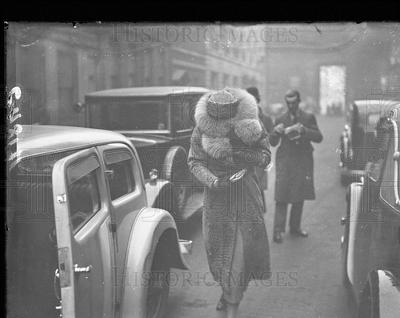
(From Antiquenaviator.com site – originally sold on Ebay)
The Court Case Between the Aviatrix and the Speed-King
Dancing through the Google searches finally yielded a lengthy article from the Detroit Free Press, 7 July 1935. I include it here in its entirety as well as several more helpful photographs.
N.B. The contentious agreement between Ursula and Weatherell was signed 14 November 1933 & the court case took place in March 1935.
Presto! And the “Hypnotic” Speed-King Got the Heiress Fortune
He awoke Her in the Middle of the Night
to Stampede Her into Signing Away Her Riches
The “evil hour,” the “hypnotic eye,” a scratch of the pen–and the deed was done.
Also, Mrs. Ursula Eileen Lloyd, 23-year-old British heiress to $600,000 and former shop girl, was undone, by that same action–until, after one of those typically spicy London high-court proceedings, with be-wigged justices sitting en banc and the pretty principal dramatically “collapsing” in the witness box at the high point in the testimony, Justice unscrambled the mess.
The “deed,” in this case, actually was a deed, in a documentary sense. It invested one Reginald Dixon Weatherell, whiz-bang motorboat designer and racing pilot, and even speedier in promoting boat-building enterprises, with the full control of Mrs. Lloyd’s investments and disbursements, save only domestic expenditures. For which stewardship the whiz-bang m.b.d. and r.p. was to be rewarded with an annual stipend of $2,600 for ten years–as “expense money”–and a bonus of $25,000, $50,000 or $75,000, to be staggered according to the amount the young heiress received under the will of her first husband, Charles Hanson, son of Sir Francis Hanson, whose drowning had widowed her when she was only 21.
Speed was the real core and consideration of the case–in fact, a dual consideration. For, as regarded Mrs. Lloyd, Weatherell’s glowing picture of a fleet of Lloyd speed boats, to be constructed by a company he was to organize and she to finance–and which would attack and annihilate all existing speed records–proved the lure that caused her to affix her signature to the agreement.
It seemed quite equitable to her, under the spell of the nautical expert’s glib talk; she was making a deal for that sizzling commodity, speed, to which, as an accomplished amateur aviatrix, land and water motorist and horsewoman, she was ardently addicted.
While, as Weatherell saw it, speed was quite an important consideration to him–and an extremely urgent one. Not as a sizzling commodity, in this instance, but as an element of space and time. For–as the Court later pointed out–all his ventures of late had been singularly unfortunate, and he was in dire need of money. He had a wife and three children to support.
So he speeded [sic] up that fateful period of the signing of the crucial document which Justice Finlay called the “evil hour”–and which happened to be at 12:30 in the morning, a rather unseemly time at which to transact business, one would think.
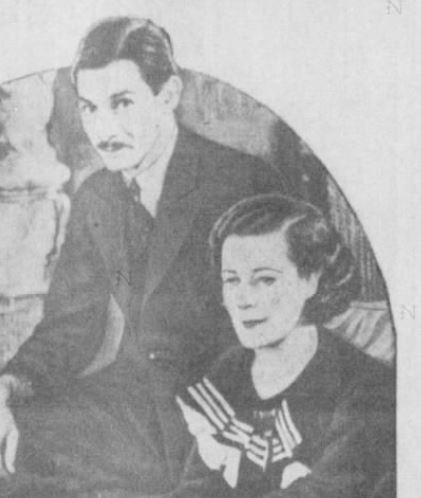
(Detroit Free Press – 7 July 1935)
When Mrs. Lloyd took the stand, she was asked pointedly about the circumstances surrounding the signing of the agreement which she now sought to have voided.
“Could you suggest anything in the document that is difficult to understand?”
“It is not difficult for me to understand now,” was the plaintiff’s quick reply, with a knowing glance at the defendant.
“Can you conceive of anyone of your age being muddled as to the meaning of a single paragraph of this agreement?”
“Yes–in the circumstances.”
“What circumstances?”
“Illness and sleeping draughts–being awakened in the middle of the night–and with two men arguing with me at the same time.”
The other man referred to was her husband, Capt. Charles Lloyd, a retired army captain and air survey pilot.
“I was very angry,” said the officer, referring to Weatherell’s midnight intrusion. “I was amazed to see what was in the document and objected to her signing it. He said he’d change it to suit us. As I still would not agree, my wife got hysterical, snatched the document from him and signed it.”
For Mrs. Lloyd believed in speed–and so did Weatherell.
Suggestions of clandestine meetings and overnight rendezvous at hotels were charged against the promoter in earlier testimony by Mrs. Lloyd–and of these her husband said:
“I saw my wife as being under the thumb of Weatherell; being held by his power of persuasion and the use of this power to his own ends. This power appeared to be of a mesmeric nature.”
Wise Mr. Justice Finlay, in summing up, said he thought there was no doubt that the agreement was “an extraordinary document, which ought not to have been signed without careful advice and consideration”–in which opinion the jury concurred, deciding in favor of Mrs. Lloyd.
And the Judge also ordered that Mrs. Lloyd be reimbursed for her outlay in bringing the action–so that Mr. Weatherell will not be altogether without the exercise of his occupation: this time the promotion of those court costs.
Well… that’s rather a dramatic story. I found a blog post on Reginald Dixon Weatherell which confirms the gist of this story and adds additional information. I won’t include it here as I don’t want to get sucked down the Weatherell rabbit hole. Numerous newspapers in England also carried the story, in less dramatic fashion. With all of this information to hand, tracking down Ursula was a bit easier.
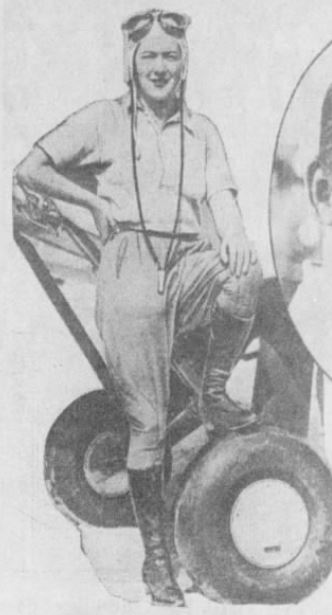
Early Life of Ursula Eileen Quinn
Our future aviatrix was born 3 December 1911 in Blackburn, Lancashire to master painter James Quinn and his wife Jane Ann Ashworth. The couple had several other children, only three of whom survived childhood. According to one newspaper article, Ursula attended St. Alban’s School and later continued her education at Layton Hill, near Blackpool.
As a young adult, Ursula went to London where she worked in the British and Dominions Imperial Studios, appearing in a small role in Sidney Howard’s 1932 comedy film “The Mayor’s Nest“. While working at the studios, she met her first husband, Charles Reginald Francis Hanson. Charles (born 1904) was the only son of of the late Sir Francis Stanhope Hanson a well-to-do London merchant. Upon his death in 1910, Sir Francis left his widow and heir (Charles) an estate valued at over £415,000 (the equivalent of roughly £46,000,000 today). The entire estate passed to Charles in 1927 upon the death of his mother. Suffice to say, Charles was very, very well-heeled.
Marriage to Charles Reginald Francis Hanson
In the second quarter of 1932, Ursula and Charles were wed in Staines but tragedy struck a year later. According to one newspaper article, shortly before midnight on 30 May 1933, Hanson left the Weir Hotel, Sunbury in a dinghy to cross the Thames. He was accompanied by Philip Reed, son of the hotel’s licensee. At some point during the crossing, the craft was “suddenly upset” and the two men, and a dog, were tossed into the water. Reed and the dog swam ashore but Charles never surfaced.
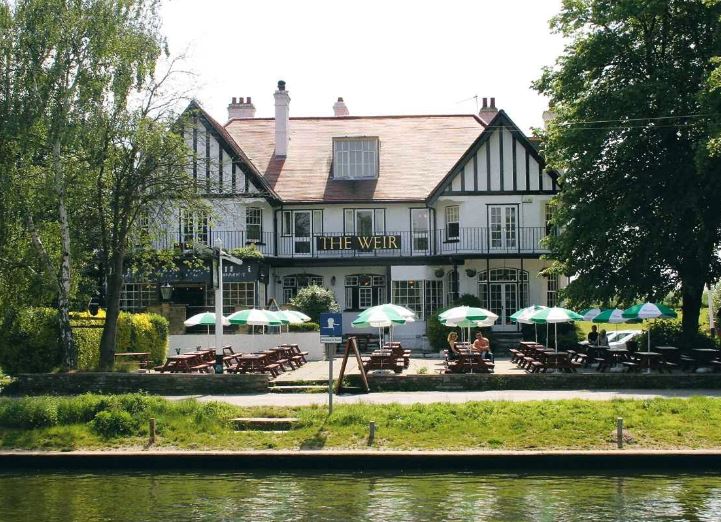
Charles Reginald Francis Hanson drowned in the Thames on 30 May 1933 while being rowed across the river from the Weir Hotel.
An inquest was held into the death of Charles Hanson and ultimately concluded he drowned accidentally, thanks to the rompings of the clumsy dog.
BOATING FATALITY ATTRIBUTED TO DOG
Caused Mix-Up on Boat
Man Drowned by Overturning
Survivor’s Amazing Story
The statement that a dog caused the overturning of a boat was made at the inquest at Hersham, Surrey, to-day on Charles Reginald Francis Hanson (29), of Wheatley’s Island, Walton-on-Thames, who was drowned in the river on Tuesday night.
Mrs. Ursula Hanson, the widow, said that about eleven [pm] her husband and a Mr. Reed left to cross the river to the Weir Hotel.
“Shortly afterwards I heard my dog Spider barking and winning [sic]. I thought he had hurt himself so I went out and called. Then I heard Mr. Reed shout–“Get help! Get help!”
Phillip Henry George Reed, of the Weir Hotel said that after they had got into the boat, Spider jumped aboard.
A Mix-up
“There was a mix-up and Charles had the tiller across his legs. I tried to help him pull the dog down, but it started rushing about and over went the boat.
“I felt a crack on the head and the next I heard was someone shouting to me to swim.”
Mrs. Ethel Chennell, of Wheatley’s Island, said that she saw Spider swimming in the river. He was a clumsy dog, and jumping into boats was a habit of his.
It was stated that the body was recovered the next day.
Dragging had since been carried on in an endeavour to find the boat.
Evidence was given that Hanson was a good swimmer, and it was suggested that he had been held down by the boat.
A verdict of accidentally drowned was recorded.
The initial reports of Hanson’s death noted that he was crossing the Thames from the Weir Hotel, but the inquest would seem to indicate that he was departing from his home on Wheatley Island. Perhaps he was a regular at the Weir Hotel and Philip had been sent in the dinghy to convey Hanson to the hotel. Wheatley Island is just upstream (west) of the Weir Hotel, on the opposite bank of the river. I was able to confirm via the electoral rolls that Charles and Ursula had a home there named Summerhouse. Sadly, they only had a year to enjoy their marriage before Charles passed away.
At the age of 21, Ursula was a grieving widow, but one who sought distraction in the most unusual ways, thanks in large part to the fortune left to her by her dearly departed husband.
High Flying Plans for Jersey and the Amazon
On 13 August 1933, Maud Dawson, in her column in Reynold’s Newspaper wrote the following rather snippy piece on Ursula:
Over the Garden Wall
In our little street any number of mighty dramas play themselves out every week. The cure for all our sorrows is, in the words of Joan Barry, who is playing in “Proscenium” in London: “Work–just work.”
Some people think differently. There is Mrs. Ursula Hanson, for instance. She is, in case you don’t know, the 21-year-old widow of the City magnate’s son who was drowned in the Thames at Whitsun.
She is taking to the air. We are told it is to forget. She is not yet able to fly, of course, but already schemes for starting an aerial service from Jersey to England are being planned. Then she’s going to explore the Amazon by air to open up an Empire route in the Pacific. The schemes are all right; they appear to be almost complete. The whole drawback to date is that Mrs. Hanson cannot yet fly. Too bad. [Ouch]
A follow-up article in Reynold’s Newspaper, not written by the snide Maud Dawson, confirmed that Ursula really was planning a trip to the Amazon.
Up the Amazon
Woman to Lead Jungle Search for Colonel Fawcett
Yet another expedition to the Central Amazon is to attempt to elucidate the mystery of the disappearance of Colonel H.P. Fawcett and his party. [Percy Fawcett’s fate is still a mystery.]
Mrs. Ursula Hanson, who is to lead, finance and select a party to proceed by air on this perilous venture, said to “Reynold’s” correspondent, at Jersey, last night, “I will certainly do it. It is my duty to go.”
Mrs. Hanson added, “No doubt, my projected trip to the jungle of unknown Brazil has been misconnected with the proposed expedition of my husband, lately deceased. Mr. Charles Hanson, before he lost his life in the Thames last Whitsuntide, had been making plans for a trip in our deep sea cruising yacht Sunfinder. We were going to cross the ocean in her, together, and proceed up the Amazon. My idea now, however, is to abandon the yacht and proceed by air.”
Right. Our young widowed heiress had some very ambitious plans. Expensive plans too. She also didn’t let her grief over her husband’s tragic death stop her from enjoying the company of adventurous men.
During the 1935 court case regarding the Weatherell document, the prosecution sought to portray Ursula as a woman of questionable morals who engaged in affairs with men, including Weatherell and, interestingly, the young man from Charles Hanson’s dinghy, Philip Reed. Apparently Reed had been staying at the same hotel on Jersey as Ursula in the fall of 1933 (after Hanson’s death). Ursula vehemently denied that they had lived together (i.e. had sex) although she admitted that she and Charles Lloyd lived together for several weeks before getting married in October 1933.
The appearance of Philip Reed in Jersey, an odd location for the son of a hotel operator, does raise the spectre of a less than innocent end to Charles Hanson. There were no witnesses to what transpired on the dinghy on the Thames, and the only survivor was the young man who later met Ursula on Jersey. Suspicious? Perhaps.
Marriage to Charles Lloyd
While on Jersey, Ursula also encountered Captain Charles Lloyd, an aviator who was giving flights to holiday-makers. He likely took her up in his aircraft and her taste for adventure reached new heights. She became a keen aviator and decided to join Captain Lloyd on a flight to India, which, unfortunately, did not have an auspicious start.
Air Crash in Jersey
Widow’s Escape in First Stage
Of India Flight
St. Helier (Jersey, Sunday) [published in the 2 October, 1933, edition of the Leeds Mercury]
Mrs. Ursula Hanson, the 21-year-old widow of Mr. Charles Hanson, who was drowned in the Thames last Whitsuntide, had a remarkable escape in an air crash on Quenvais [Les Quennevais] racecourse, Jersey, to-day.
With Captain C. Lloyd as pilot and a male passenger named Fletcher, the machine was taking off for Heston, London, on the initial stages of a flight to India, when it crashed into a fence and burst into flames.
Mrs. Ursula Hanson escaped with slight burns and bruises. Captain Lloyd sustained a cut over the eye, and Mr. Fletcher escaped with slight injury. This was the first air crash in Jersey.
Mrs. Hanson told a reporter: “I am going to England as soon as possible to buy another machine for my flights to India, where I intend to stage several air pageants to further the interests of British aviation in the East.” [Incidentally, this was the first aeroplane crash in Jersey.]
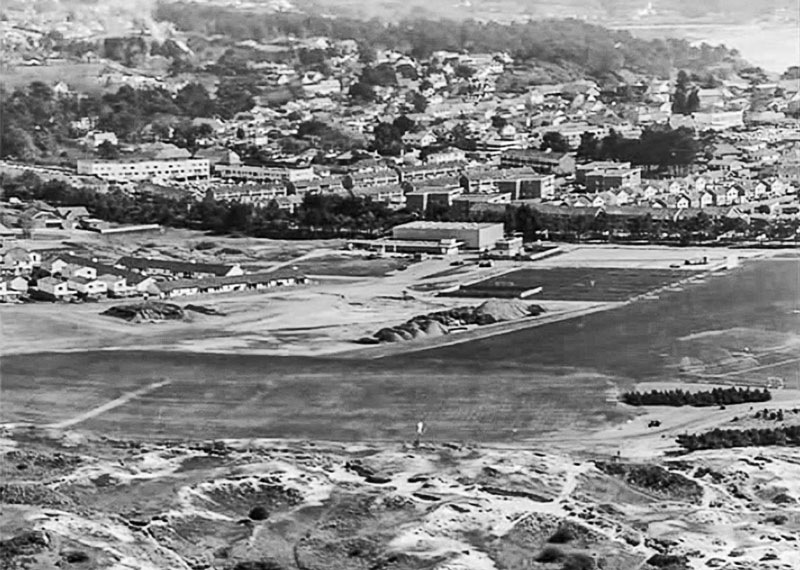
(From Jerripedia)
It would seem that the trip to Amazon was off the books. Whether Ursula and Charles ever made it to India is unknown. What we do know is that on 27 October, 1933, less than five months after Hanson’s tragic death, the two tied the knot in Westminster, London. Perhaps Charles Lloyd had a more measured view of the future and was a stabilizing influence on the rather flighty heiress. The fact that the pair were newlyweds puts a bit more context to the mid-November tussle with Weatherell. Some of the newspaper articles that covered the court case in 1935 seemed to question the “manhood” of Charles Lloyd, wondering how he could have allowed his wife to sign such a document. I would hazard a guess that Ursula was a tad headstrong and, as one article noted, she snatched the document from her husband and signed it with a flourish, despite Charles’ protestations.

Crashing out in Abyssinia
The court case took place in March 1935 and a few months later, the Lloyds were off on an adventure, flying to Khartoum, north of Abyssinia. As noted above in Robinson’s report, the pair departed Khartoum (now part of Sudan) in their Monospar aeroplane on 20 December 1935. The aircraft experienced engine failure which forced them to land near Addis Alem, just west of Addis Ababa. Their forced landing was not without danger, as Ursula later told a New Zealand reporter:
Adventurous Life
Wanganui Chronicle, Volume 80, Issue 179, 1 August 1938, page 2.
A visitor to New Zealand, Mrs. Ursula Lloyd, of England, has had [an] unusually active and adventurous life. She had the experience of being held for ransom by Abysinian [sic] natives after a forced landing while flying from Khartoum to Addis Ababa. Flying, bear-shooting, fishing and ski-ing are among the activities which have claimed Mrs. Lloyd’s attention, and she holds the distinction of having made the record catch from the Blue Nile. The fish was a Nile perch weighing 167.5 lb and was caught at the Sennar Dam, just south of Khartoum. A keen airwoman, Mrs. Lloyd owns her own aeroplane, and when she married Captain Charles Lloyd, an air surveyor, in 1933, she flew with him to Abyssinia. In the flight, from Khartoum to Addis Ababa, one engine cut out and a forced landing was made. Abyssinian natives surrounded the machine and took Captain and Mrs. Lloyd prisoners, being first intent on putting them to death, and later deciding to hold them instead to ransom. The prisoners were put into a stick and mud hut for three days with 22 natives, and the food offered them was so filthy that they were unable to touch it. At length word came through from the English Consul at Addis Ababa to release the prisoners and send them to the capital. But here bad luck again attended them. The damaged engine, which they had attempted to repair, again cut out and the aeroplane crashed into a tree, Mrs. Lloyd being fairly severely injured. They had to return to the hut for another two days, after which Mrs. Lloyd was carried on a stretcher by the natives at the run for seven hours and then transferred to a lorry. Mrs. Lloyd is a member of the Hanworth Aviation Club in England and is also a Fellow of the Royal Geographic Society. She is keenly interested in the people of the various countries she visits and paid a striking tribute to those of New Zealand. Mrs. Lloyd was a recent visitor to Chateau Tongariro.
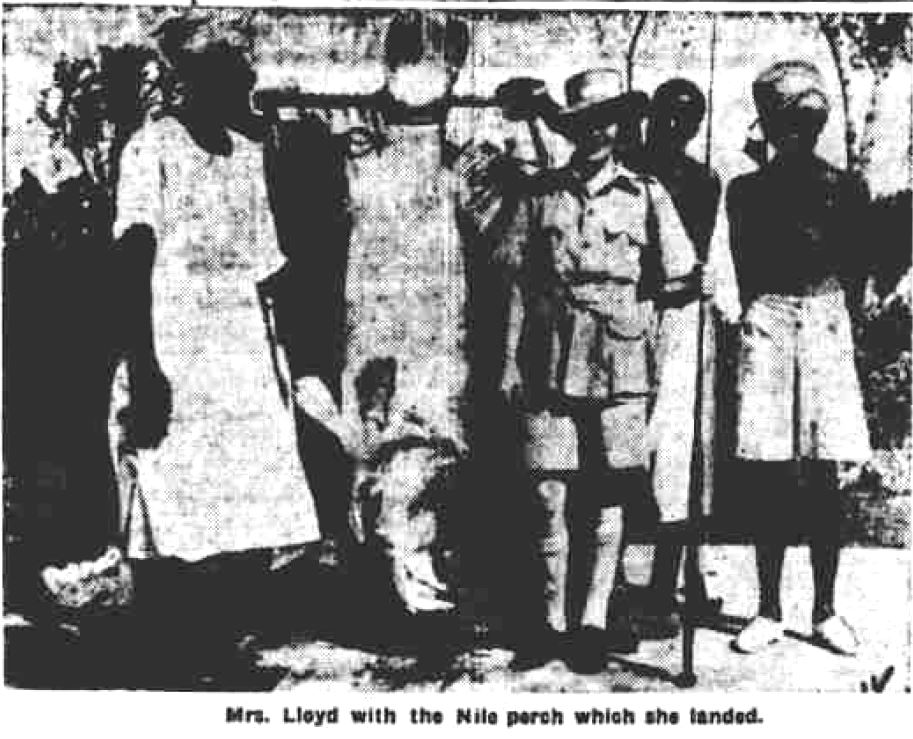
(Lancashire Daily Post, 30 December 1935 page 7)
A photograph of the crashed Monospar can be viewed on Alamy. Several months later, Ursula gave an interview to an Australian reporter from The Western Australian (29 July 1936) and filled in a few more details surrounding the crash.
According to Ursula, the shack was used as sleeping quarters by 22 natives and, while the couple had been given the only bed in the shack, it was made of badly tanned cowhide and dirty hay. The food was “rough” but Ursula didn’t mind since she was used to roughing it while they had been trekking across the Sudan. One day, the natives skinned a goat in front of them and later gave them some of the meat to eat. Whether they actually ate it is unknown. During the second crash, Ursula injured her legs quite badly and had to be stretchered for 80 miles by the natives (another source said 60 miles). She convalesced in the Swedish hospital in Addis Ababa hospital for three weeks. After her release, she stayed in the city for several weeks as she found it to be full of interest and adventure. The newspaper noted that Charles Lloyd had served in the Royal Air Force and was an enthusiastic aviator. The couple had travelled extensively in Europe, Africa and India. According to Ursula, “Abyssinia was a most interesting country, and [I have ]found the natives charming people. In the interior, they lived under very primitive conditions, but in the capital they conformed more to European standards.”
At some point during her stay in Addis Ababa, Ursula encountered the “most interesting” Captain Robin W.G. Stephens in a nightclub. Ursula made a favourable impression on Stephens as well, for he wrote about her, in his inimitable style, in his September 1936 article for St. Bart’s Hospital Journal:
There were interesting people in Addis Ababa.
The journalists, of whom there had been 120 in Addis Ababa, had thinned out. The doyen was Walter Collins, a tower of strength to Reuter; Steer of The Times, for whom there is a brilliant future. Haytor [or Hayter – the pilot mentioned early by J.C. Robinson], the pilot of an ill-starred Red Cross aeroplane. It was under-powered, but Haytor [sic] refused defeat: he crashed into trees, because the accursed engine was not up to the altitude. [Hayter’s account of the crash can be found here] The Lloyds were there. It takes courage for a woman to fly from Khartoum to Addis Ababa “to see the war”. Her monospar disliked the altitude, and there was a crash in taking off. For five days these two languished as prisoners in a filthy “Tukkul” (hut). Through the night torches were held aloft by slaves, who were flogged if they moved.
Count von Rosen, Goering’s nephew so they say, [nephew of Goering’s wife, Carin] the pilot of the Red Cross Fokker, had with him his pretty fiancée; she was an oddity, of quiet temperament and a parachutist of international fame.
Stephens might not have tagged Ursula as the “most interesting woman” he had ever met, but she did impress him with her courage for flying over an active war zone just to “see the war”.
Ursula (and possibly Charles) finally left Addis Ababa on 7 March 1936, spending three weeks in Djibouti, “a most interesting city” before departing aboard a French cargo-cum-passenger ship. Two days out, however, Ursula developed malaria and had to be put ashore in Port Said. She remained there for a month, convalescing in a British hospital before catching an Italian ship to Genoa. From Genoa, she travelled to Venice, Vienna, Kraków, Prague and finally London, just in time to catch a ship for Australia. Arriving in Fremantle (on the western coast of Australia), Ursula planned to catch the transcontinental railway and visit relatives (her sister) in the eastern states.
Globe Trotting Aviatrix
What we do know is that Ursula was a whirl-wind traveller, and her journeys continued through the late 1930s and into the 1940s… America, Hong Kong, Australia, New Zealand, England, India, and back again. The interesting thing is… she never travelled with her husband. She always gave her status as “married” but she was a housewife of independent means who travelled alone. The aforementioned blog on Reginald Dixon Weatherell speculated that Ursula and Charles may have separated and I suppose that is possible. We do know that in the 1936 Electoral Register, the two were residing at 11 Grosvenor Cottages in London. But after that… I can find no trace of her in the electoral registers. Perhaps because she was travelling…
One travel document stands out from the others. On 22 February 1943, she arrived in New York aboard the S.S. Themistocles having departed Sydney, Australia, her former permanent residence. Unlike other passenger manifests, however, where she gave her nearest kin as her mother, on this manifest, she gave her next of kin as Major Charles Lloyd, Permanent Staff of the Geographical Section of the War Office in London. It’s enough to make one’s head spin. Were she and Charles separated or not? Why was she travelling on an ocean liner during the height of the Second World War?
After the war, in 1946, Ursula departed Liverpool aboard the Empress of Scotland, bound for Bombay, India. She planned to make India her “permanent residence” and still gave her status as “married” but was not accompanied by her husband.
I was unable to track Charles Lloyd through the genealogy sites. His name is far too common and none of the newspaper articles give any identifying information which might help identify him. Ordering the marriage registration might provide helpful information, but for a fee. Given that Ursula had a significant inheritance from her first husband, I rather doubt that the couple would have divorced as Ursula would have had to give up half of her wealth to Charles. Thanks to a link sent by blog reader Giles, I was able to find a bit of information on Charles in a book by Lettice Curtis, an aviatrix who served in the Air Transport Auxiliary during the Second World War. In her autobiography (snippets of which are available on Google Books), Lettice tells us that Charles Lloyd served with the British Army during the First World War during which time he was seconded to the Royal Air Force to do survey work in Egypt. After the war, he was involved in surveys in India, Burma and Africa. By 1938, Charles owned a company called C.L. Air Surveys and had been awarded a contract to take aerial photographs of England so that the Ordnance Survey 25 inch maps could be updated. Lettice, and other female pilots, were hired by Charles to fly some of these aerial photograph routes. This may explain the absence of Charles on Ursula’s mad dashes about the globe. He was running a business and happily flying aircraft around England, while she was sailing around the world chasing other adventures.
Unfortunately for Ursula, her adventures ended prematurely when she passed away on 12 October 1956 in South Africa. She had been residing at 284 Cape Road, Port Elizabeth, Cape Province and was listed as a single woman in the newspaper notice of her death. She was only 44 years old which seems awfully young. According to the probate index, her estate was valued at £6,000, which is the equivalent of about £150,000 today. It’s hard to imagine that Ursula could have blown through millions of pounds in 20 years but… she did have a tendency for impulsivity. N.B. I wrote another post about Ursula’s probate after receiving a copy of it.
Conclusion
It is rather satisfying to see the mutual connection between Ursula Eileen Lloyd and Robin Stephens. They each mentioned the other and it forms a nice neat circle. Ursula sounds like a rather lively character who lived life hard and fast. She was a woman with humble beginnings who came into a fortune early in life. She seems to have spent that fortune on fast aeroplanes, impulsive travel and good times. She lived hard and fast and died young. Perhaps it was another aeroplane crash that claimed her life, a crash that she did not walk away from. Or perhaps it was a motor vehicle accident. Perhaps something else entirely.
Thanks
Many thanks to Giles for pointing out the Sydney Sun article, it’s added another puzzle piece to the story of Robin Stephens.
Post Script
While researching this post, I came across the story of Frederick Hayter, the Red Cross pilot who crashed after take-off. It mentioned another Red Cross pilot, Swedish Count Carl Gustaf von Rosen, who was also mentioned by Stephens. Von Rosen’s daughter-in-law has published a book on his exploits which apparently contains some photographs of his time in Abyssinia, including at least one photograph of the Lloyds after their crash. She may also have some photographs of the British Ambulance Service in Ethiopia. I’ve reached out to her to see… and ordered a copy of her book.
Sources
Ancestry – genealogical records
Various newspaper articles
Facebook Page on Imperial Ethiopian Air Force – quotes from John Charles Robinson – mentions the Lloyd couple in Addis Ababa
Facebook Page on Imperial Ethiopian Air Force – has an article about Red Cross pilot Captain Frederick Charles Edney-Hayter
Aviation Safety Network – report on the crash of G-ADTE in 1938
UK Register of Civil Aircraft – Report on her aircraft G-ADTE
Antique Naviator site – has a photograph (sold) of heiress Ursula Eileen Lloyd
Detroit Free Press – 7 July 1935 – The Sunday Magazine insert
Kilburn and Willesden History site – has a blog post on Reginald Dixon Weatherell and mentions the court case with U.E. Lloyd.

Hello Giselle
Your post is most intriguing and fascinating. And thank you for doing the hard work tracking the redoubtable Mrs Ursula Eileen Lloyd and Capt. Charles Lloyd.
Superb research! I would be really interested in knowing how you search using google and refine your search terms.
I would like to add a few points.
The reports of the Lloyd-Weatherell court case, even by today’s standards are fairly racey and would not be out of place on the front page of the more lurid Dailys in the UK; but by the standards of 1935 the court proceedings were positively scandalous.
Understandably, the case received considerable coverage in the UK press, and the Times reports, while restrained, nevertheless convey much detail and certainly enough to entice a reader to buy the next edition. It had everything, money, and lots of it; aeroplanes and fast boats, the Formula-1 combination of the time, a young widow, of very modest background (the hint of class snobbery and gold-digging suffuses the articles) whose first husband, from whom she inherited, died in a tragic, freak accident late at night, possibly in company of a man with whom Mrs Lloyd may later have had some brief association. Later, Mrs Lloyd enters into a business relationship with a Mr Weatherell and there are not so subtle suggestions of late night tete-a-tetes, in the absence of her husband and when he was present. Much is left to the reader’s imagination, fuelled by carefully worded innuendo (and certainly the not to subtle suggestion that Mrs Lloyd had an active social diary). The double standards are palpable.
The fact that Mrs Lloyd appeared to live in Australia for a couple of years in the early part of the War and then departed in February 1943, is most intriguing. Her sister resided in Sydney, as you discovered, but her name appears unknown. Leaving Australia during the war, as a civilian, was quite difficult. Diplomatic personnel and government employees could, but for private individuals is was much more difficult. Her travels through central Europe and then onto the Far east and then to North America raises all sorts of questions.
I can add a little more information on Capt. Lloyd’s post war activities.
Prior to the war, as you know, Capt. Lloyd operated an aerial survey company. This appears to have resumed operations after the war ended when the then Lieut.-Colonel Lloyd de-mobilised. The company was still called C L Air Surveys Ltd and operated in East Africa, although it appears to have maintained offices in London. C L Air Surveys operated an airline called C L Airways (sometimes clairways). The airline used surplus ex-RAF Mk. 1 Ansons and flew routes in East Africa. [See key-aero link below, which provides some detail.]
It appears from Commons debates in January and again in March, 1949 [Hansard links below] that CL Airways experienced financial difficulties, which some attributed to actions by the UK Government and its nationalised airline, BOAC. This was subject to parliamentary discussion [Hansard links below].
It would appear that the airline and the survey company were wound up in the early 1950s. The location of CL Air activities in East Africa and its financial problems may explain why Ursula Lloyd died in South Africa in the mid 1950s, with only a small estate compared to her inheritance. Her cause of death may also be relevant.
Thank you for dropping down this rabbit-hole and all your hard work; it is most diverting, and at this time, where COVID is keeping some of us at home, a pleasure to read.
Links
https://www.key.aero/forum/historic-aviation/c-l-air-surveys-ltd
https://hansard.parliament.uk/Commons/1949-01-26/debates/60cd26cd-c0e0-4ed7-858c-aa1d2690fbc2/CommonsChamber
https://api.parliament.uk/historic-hansard/commons/1949/mar/02/clairways-limited
Hi Giles,
Thanks!! It was a bit of a rabbit hole and I’m still burrowing away. I request the UK Will/Probate info on Ursula in mid-January but have had several hiccups. Hoping it will come this week and might answer a few questions – specifically if Charles is listed as a beneficiary. Your thoughts on her location in South Africa and Clairways is intriguing… going to have do some more digging. Maybe Charles passed away there too…
Google Search – it’s a bit of an art, to say the least. I tend to use a lot of boolean operators and “”.
+”ursula eileen lloyd” (the plus forces it to look for the item – the double quotes force it to look for it as a phrase. I sometimes use the minus sign which tells Google to ignore anything (e.g. -“australia”)
I tend to always use + or – even if it’s just a single word…
e.g. +”josef jakobs” +”tower” -“spargelhof” (there is a Josef Jakobs Spargelhof (asparagus farm) that keeps contaminating my searches!).
I then tweak things and add in other words – so with Ursula, I might just do “U.E. lloyd” – I might add “aviatrix” or “Australia” or “ethiopia” – it all depends.
Happy hunting! Glad that I can alleviate the tedium of Covid for my readers!
Giselle